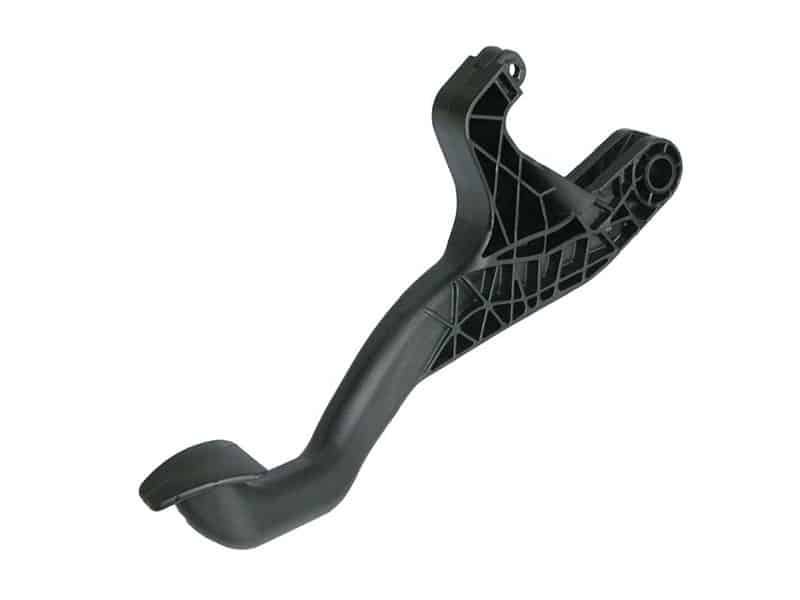The water assisted injection molding process, one of injection molding types, builds on traditional injection molding by using water pressure to displace material and form internal cavities. It addresses challenges in thick-walled components. The water assisted injection molding technique is widely used for lightweight , hollow, and structurally stable plastic components.
What is Water Assisted Injection Molding and Its Principle?
Water assisted injection moulding involves injecting polymer melt into a mold cavity followed by high-pressure water to expand and shape the interior. The water assisted injection molding process working principle is similar to gas-assisted injection molding, but water, due to its higher density and thermal conductivity, provides better cooling efficiency and more consistent wall thickness in the hollow sections.
Key steps in the water assisted injection molding process include:
- Injection phase: Molten plastic is first injected into the mold cavity, partially filling it.
- Water injection: High-pressure water is introduced through a specially designed nozzle, pushing the molten core material to the periphery of the cavity.
- Holding and cooling: The water remains inside the cavity to assist heat transfer, cooling the plastic uniformly.
- Water evacuation: The water is then drained, and the molded part is ejected after solidification.
Materials Used in Water Assisted Injection Molding
Not all thermoplastics are suitable for water assisted injection moulding. Materials for water assist injection molding require modifications to slow crystallization and prevent wall penetration. Commonly used materials include:
Polyamide (PA): Excellent toughness and resistance to high temperatures; often used for automotive applications.
Polypropylene (PP): Lightweight, cost-effective, and widely applicable for consumer and household products.
Acrylonitrile Butadiene Styrene (ABS): Good mechanical strength and surface finish, suitable for handles and appliance housings.
Polyethylene (PE): High flexibility and chemical resistance, often used for tubing and handles.
Advantages and Disadvantages of Water Assisted Molding
Advantages of Water Assisted Molding
- Improved Cooling Efficiency: Water has superior thermal conductivity compared to air, significantly reducing cooling time and cycle duration.
- Reduced Warpage and Sink Marks: Uniform cooling and even wall thickness minimize deformation and visual defects.
- Uniform Wall Thickness: Wall thickness achieves better uniformity and thinner profiles.
- Smooth Internal Surface Finish: Inner surfaces become smoother compared to gas methods.
- Enhanced Structural Rigidity: The hollow sections provide a high strength-to-weight ratio, ideal for large, load-bearing hollow parts.
- Material Savings: Material usage drops by up to 42%, as seen in automotive tube applications.
- Lower Cost: High production rates benefit from lower variable costs in full-shot modes. And, water costs less than nitrogen and avoids licensing fees.
Disadvantages of Water Assisted Molding
Complex Mold Design: Special water channels and sealing systems increase mold design complexity and cost.
- More Complex Process: Drainage requires gravity and air assistance, which complicates the process and risks residual water.
- Higher Equipment Cost: Dedicated water injection units and valves increase overall investment compared to conventional molding.
- Process Control Requirements: Process parameters show high sensitivity, resulting in potential leaks or wall perforations.
Common Applications of Water Assisted Injection Molding
Water-assisted injection molding (WAIM) enables the production of hollow or partially hollow plastic parts with precise wall thickness and complex shapes that are difficult to achieve with conventional injection molding.
By using water to form the internal cavity during molding, designers can create lighter components with larger cross-sections or thinner walls, which saves material and reduces cycle times. This makes WAIM ideal for a variety of applications, from automotive parts such as cooling pipes and air ducts to consumer products like furniture handles, armrests, and decorative components.
In addition, the technique allows innovative effects: colored water can be injected into the core of a transparent or translucent part, creating visually striking products without additional assembly steps.
Common Problems in Water Assisted Injection Molding
Although water assisted injection molding offers many benefits, there are some challenges in process.
Water Bubbles, Ripples, or Swirls at Needle Entry
These defects occur due to abrupt water entry or high initial pressure, disrupting melt flow at the needle point. Use high-flow low-pressure injection at the start and gradually increase pressure to smooth the interface.
Local Steam Molding or Cracks
Fast-cooling materials solidify unevenly, creating steam pockets or cracks from rapid contraction. Select slower-cooling materials and apply overflow control to manage pressure and temperature gradients.
Fiber Washout Leading to Rough Walls
In filled polymers, water flow erodes fibers, exposing rough inner surfaces. Optimize filler types and concentrations, or adjust water velocity to minimize erosion.
Incomplete Drainage Blocking Needles or Invading Hot Runners
Residual water or plastic residue clogs components due to poor drainage timing or design. Implement steam or vacuum drainage systems and ensure precise timing to clear paths fully.
Comparison Between Water Assisted and Gas Assisted Injection Molding
| Aspect | Water Assisted Injection Molding | Gas Assisted Injection Molding |
|---|---|---|
| Core Medium | High-pressure water | High-pressure nitrogen ga |
| Wall Thickness Uniformity | More uniform | Slightly less uniform |
| Surface Quality | Smooth internal surface | Potentially rougher internal surface |
| Process Control | More complex (pressure and sealing) | Easier to control |
| Cost | High initial (coatings), low variable in full-shot | Lower critical volume in short-shot, license adds |
| Suitable Materials | Limited to moisture-resistant plastics | Broader range of thermoplastics |
| Application Areas | Automotive handles, pipes, appliance parts | Large hollow parts, furniture, automotive trim |
Conclusion
The water assisted injection molding process transforms thick-walled part production with efficient hollow formation. It complements gas methods by addressing cooling and uniformity gaps. Challenges like drainage and corrosion persist but yield to material and mold optimizations. For plastic injection molding manufacturer seeking to integrate this technology, partnering with experienced molding specialists is essential to ensure optimal process design and production performance.



